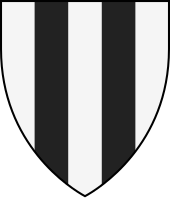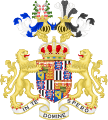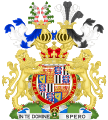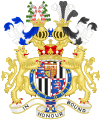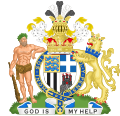House Battenberg
Battenberg , named after the town of the same name on the Eder , is a morganatic sideline of the House of Hesse .
prehistory
Already in the Middle Ages there was a family with this name that was not related to the House of Hesse and went back to Werner I. von Battenberg and Wittgenstein (* around 1150; † 1215). It ruled over the county of Battenberg and died out in 1310. Subsequently, the title Graf von Battenberg was vacant.
After 1851: descendants of Prince Alexander of Hesse
Overview of the family branches
From 1851 to 1917/1924 "Battenberg" served as the name of the descendants from the morganatic marriage of Prince Alexander von Hessen-Darmstadt (1823–1888) with Countess Julia Hauke (1825–1895). She was the orphaned daughter of the deputy war minister of Congress Poland , Count Hans Moritz Hauke , and lady-in-waiting of Prince Alexander's sister Maria Alexandrovna , wife of Tsar Alexander II. The descendants from this unequal marriage were not entitled to inheritance in the succession of the Grand Ducal Hessian throne . Grand Duke Ludwig III. von Hessen and bei Rhein ( Hessen-Darmstadt ), Alexander's brother, awarded Julia Hauke on November 5, 1851 the orphaned title of Countess von Battenberg, which had been orphaned since 1310. In 1858 he made her princess of Battenberg. The Grand Duke assigned Heiligenberg Castle to the new Battenberg line , which had come into his possession through inheritance and thus became their "ancestral castle". It is located on a promontory on Bergstrasse , in what is now the municipality of Seeheim-Jugenheim .
Prince Alexander of Hessen-Darmstadt and his wife had several children, of which the sons later established several branches of the family:
- Ludwig von Battenberg (1854–1921) moved to England and joined the Royal Navy in 1868 . In 1917 he renounced the title of Prince of Battenberg and took the Anglicized name Mountbatten for himself and his descendants , at the same time he was appointed Marquess of Milford Haven . The later Marquesses of Milford Haven descend from his eldest son George , the Earls Mountbatten of Burma from his younger son Louis .
- Alexander von Battenberg (1857-1893) was the ruling prince of Bulgaria from 1879 to 1886 . When he married in 1889, he renounced his previous titles and received the Hessian title of Count of Hartenau .
- Heinrich von Battenberg (1858-1896) also moved to England and in 1885 married the British Princess Beatrice . His son Alexander (1886-1960) also renounced the title of Prince of Battenberg in 1917 and adopted the Anglicized name Mountbatten for himself and his descendants , at the same time he was appointed Marquess of Carisbrooke . However, the 1st Marquess of Carisbrooke left no male offspring.
- Franz Joseph von Battenberg (1861-1924) married Princess Anna of Montenegro in 1897 . He carried the title of Prince of Battenberg until the end of his life, but had no descendants.
Details on individual branches of the family
Bulgaria / Hartenau
The house of Battenberg was the ruling dynasty of Bulgaria from 1879 to 1886 , as Prince Alexander von Battenberg (1857-1893), the second-born son of Prince Alexander of Hesse-Darmstadt and Julia Hauke, Princess of Battenberg, as Prince Alexander I of Bulgaria was. The consequence of pro-Russian coup attempts and coups was the abdication of Alexander on September 7, 1886.
In 1889, Alexander von Battenberg married the Austrian opera singer Johanna Loisinger (1865–1951) in southern France and renounced his previous titles. Instead of the name Battenberg, he received the hereditary title and name Graf von Hartenau through the Grand Ducal Hessian award on January 11, 1889 in Darmstadt . The coat of arms awarded at the same time was composed of the coats of arms of Hesse, Battenberg, Eastern Rumelia and Bulgaria.
The Count couple von Hartenau lived in Austria and had a son in 1890 and a daughter in 1893. The former prince of Bulgaria died that same year and was buried in a mausoleum in the Bulgarian capital Sofia . His wife died in 1951 and was buried in the St. Leonhard cemetery in Graz.
The name von Hartenau is now used in the male line of descendants of the Polaczek family, who are not related by blood, since Count Alexander's son Assen Hartenau (1890–1965) gave his stepson Wilhelm (* 1915) from the first marriage of his wife Bertha, née. Hussa (1892–1971) with Alois Polaczek, adopted . Wilhelm von Hartenau and Maria Elisabeth Freiin Klein von Wisenberg became the father of a son and two daughters.
Mountbatten
The descendants of Prince Alexander living in England adopted the name Mountbatten in 1917 , a translation of the German Battenberg. Political reasons that arose from the increasing hostility towards Germans during the First World War played a role here. In the course of the Anglicisation of the name, Prince Ludwig von Battenberg was appointed hereditary Marquess of Milford Haven , his sonless nephew Alexander the hereditary Marquess of Carisbrooke .
In 1946, Louis Mountbatten , the younger son of the 1st Marquess of Milford Haven, received the hereditary title of Earl Mountbatten of Burma due to his military service in World War II .
Philip of Denmark and Greece , a nephew of the 1st Earl Mountbatten of Burma, renounced his previous title in 1947 and also took the surname Mountbatten . In the same year he married the British heir to the throne Elizabeth and received the hereditary title of Duke of Edinburgh .
Mountbatten-Windsor
According to a somewhat vaguely worded ordinance (Order-in-Council) from 1960, the name Mountbatten-Windsor is the personal surname of certain descendants of Queen Elizabeth II and Philip Mountbatten, Duke of Edinburgh . However, the official name of the royal house remains Windsor . The new name does not apply to members of the Royal Family who do not descend from Elizabeth II. The Order-in-Council applies the new surname only to descendants of Elizabeth and Philip who do not have “royal” titles, but is apparently used by all of their descendants in the Royal Family. Both Prince Charles and Anne, Princess Royal were inscribed on the marriage register as Mountbatten-Windsor . The members of the House of Mountbatten-Windsor do not belong genealogically to the House of Battenberg, the naming can be traced back to the fact that the mother Philips, the Duke of Edinburgh, belonged to the House of Battenberg. On his father's side, as Prince of Denmark and Greece, Philip bears the family name Schleswig-Holstein-Sonderburg-Glücksburg .
coat of arms
According to the diploma of 1858, the family coat of arms of the House of Battenberg shows a quartered shield; in fields 1 and 4 within red and silver decorated shield board in blue a gold crowned (Hessian) lion divided seven times by silver and red; in field 2 and 3 two black posts in silver ( Battenberg coat of arms ). Two helmets rest on the shield; on the right, with red and silver covers, two buffalo horns with seven stripes of red and silver, each with three on the outside and one green linden branch at the mouths; on the left, four ostrich feathers with black and silver covers, alternating black and silver.
The sons of the 1st Marquess of Milford Haven also wore the coat of arms of their grandmother, Princess Alice of Great Britain and Ireland , in the upper part of the Battenberg coat of arms .
The coat of arms of Prince Alexander von Battenberg (1879–1886 Prince of Bulgaria) is composed of the coat of arms of Hesse, Battenberg, Eastern Rumelia and Bulgaria. The shield is four-sided: in the blue field 1 a gold crowned lion (Hessen) striped ten times in silver and red, in the silver field 2 two black posts (Battenberg), field 3 is divided and shows under the blue head of the shield , two golden crowns of leaves next to each other , in the upper, silver field two red posts, in the red lower field two natural-colored arms with wide green sleeves protruding from the two sides, holding up a golden crown of leaves (eastern Rumelia), the red field 4 shows a green armored, golden crowned lion (Bulgaria) . Four helmets rest on the shield: the first with red and silver covers carries a silver flight, which is covered with two red stakes (eastern rumelia), the second with blue and silver covers carries two silver buffalo horns, each with a three-leaved green linden branch from each mouth and which are decorated on the outside with four-leaf branches (Hessen), the third helmet with black and silver covers wears four (black, silver, black, silver) ostrich feathers (Battenberg), the fourth helmet with red and gold covers wears one growing, golden crowned golden lion (Bulgaria). As gems about the Count leaves crown and ermine-lined red crests coat serve. Shield holders are two inward-looking golden lions. The motto is: In te Domine spero .
Known members
-
Julia Hauke (born November 12, 1825 in Warsaw, † September 19, 1895 in Jugenheim), ancestor of the second house of Battenberg, (from 1851) Countess von Battenberg, (from 1858) Princess von Battenberg
- Marie Karoline von Battenberg (born February 15, 1852 in Strasbourg, † June 20, 1923 in Schönberg), Princess of Erbach-Schönberg
-
Ludwig von Battenberg (born May 24, 1854 in Graz, † September 11, 1921 in London), (from 1917) 1st Marquess of Milford Haven
- Alice von Battenberg (born February 25, 1885 in Windsor Castle, † December 5, 1969 in Buckingham Palace)
- Louise Mountbatten (born July 13, 1889 at Heiligenberg Castle near Darmstadt, † March 7, 1965 in Stockholm), Queen of Sweden
-
George Mountbatten (born December 6, 1892 in Darmstadt, † April 8, 1938 in London), 2nd Marquess of Milford Haven
- Lady Tatiana Mountbatten (born December 16, 1917 in Edinburgh, † May 15, 1988 in Northampton)
- David Mountbatten (born May 12, 1919 in Edinburgh, † April 14, 1970 in London), 3rd Marquess of Milford Haven
-
George Mountbatten (born June 6, 1961 in London), 4th Marquess of Milford Haven
- Lady Tatiana Mountbatten (born April 16, 1990 in London)
- Henry Mountbatten (born October 19, 1991 in London), Earl of Medina
- Lord Ivar Mountbatten (born March 9, 1963 in London)
- Ella, Alexandra and Louise Mountbatten
-
George Mountbatten (born June 6, 1961 in London), 4th Marquess of Milford Haven
-
Louis Mountbatten (born June 25, 1900 in Windsor, † (murdered) August 27, 1979 in the Bay of Sligo, Ireland), 1st Earl Mountbatten of Burma, last Viceroy of India
- Patricia Mountbatten (born February 14, 1924 in London - † June 13, 2017 in Mersham), 2nd Countess Mountbatten of Burma
- Lady Pamela Mountbatten (born April 19, 1929 in Barcelona)
-
Alexander von Battenberg (born April 5, 1857 in Verona, † November 17, 1893 in Graz), ruling prince of Bulgaria (1879–1886); from 1889 Count von Hartenau
- Assen von Hartenau (born January 16, 1890 in Graz, † March 15, 1965 Vienna)
- Zwetlana von Hartenau (born October 24, 1893 in Graz, † November 24, 1935 in Oberstdorf)
-
Heinrich Moritz von Battenberg (born October 5, 1858 in Milan; † (malaria) January 20, 1896 off the coast of Sierra Leone on board the HMS Blonde)
- Alexander von Battenberg (born November 3, 1886 in Windsor Castle, † February 23, 1960 in Kensington Palace), (from 1917) 1st Marquess of Carisbrooke
- Lady Iris Mountbatten (born January 13, 1920 in London, † September 1, 1982 in Toronto)
- Victoria Eugénie von Battenberg (born October 24, 1887 in Balmoral, † April 15, 1969 in Lausanne), Queen of Spain
- Leopold von Battenberg (born May 21, 1889 in Windsor Castle, † April 23, 1922 in Kensington Palace)
- Maurice von Battenberg (born October 3, 1891 in Balmoral, † (fallen) October 27, 1914 in Ypres)
- Alexander von Battenberg (born November 3, 1886 in Windsor Castle, † February 23, 1960 in Kensington Palace), (from 1917) 1st Marquess of Carisbrooke
- Franz Joseph von Battenberg (born September 24, 1861 in Padua, † July 31, 1924 in Schaffhausen)
Descendants who do not belong to the Battenberg family, but descend from it and bear his name
- The children of King Alfonso XIII. of Spain and Princess Victoria Eugénie von Battenberg , belong to the House of Bourbon :
- Prince Alfonso de Borbón y Battenberg, Infante of Spain, Count of Covadonga (1907–1938)
- Prince Jaime de Borbón y Battenberg , Infante of Spain, Duke of Segovia (1908–1975)
- Princess Beatrice Isabel de Borbón y Battenberg , Infanta of Spain (1909–2002)
- Princess Maria Cristina de Borbón y Battenberg, Infanta of Spain (1911–1996)
- Prince Juan de Borbón y Battenberg , Infante of Spain, Count of Barcelona (1913–1993),
- Prince Gonzalo Manuel de Borbón y Battenberg , Infante of Spain (1914–1934)
- The son of Prince Andreas of Greece and Denmark and Princess Alice von Battenberg and his descendants belong to the House of Oldenburg (the descendants of Philip and Elizabeth, however, have the surname Mountbatten-Windsor ):
- Prince Philip Mountbatten, Duke of Edinburgh , Earl of Merioneth, Baron Greenwich, (* 1921), husband of Queen Elizabeth II of Great Britain .
- Prince Charles Mountbatten-Windsor, Prince of Wales , Duke of Cornwall , Duke of Rothesay , Earl of Carrick , Baron of Renfrew , Lord of the Isles and Prince and Grand Steward of Scotland, (* 1948), since 1953 heir to the throne of the United Kingdom of Great Britain and Northern Ireland
- Prince William Mountbatten-Windsor, Duke of Cambridge , Earl of Strathearn , Baron Carrickfergus, (* 1982)
- Prince George Mountbatten-Windsor (* 2013)
- Princess Charlotte Mountbatten-Windsor (* 2015)
- Prince Louis Mountbatten-Windsor (* 2018)
- Prince Henry Mountbatten-Windsor, Duke of Sussex , Earl of Dumbarton , Baron Kilkeel (* 1984)
- Archie Harrison Mountbatten-Windsor (* 2019)
- Prince William Mountbatten-Windsor, Duke of Cambridge , Earl of Strathearn , Baron Carrickfergus, (* 1982)
- Princess Anne Mountbatten-Windsor, Princess Royal , (* 1950)
- Prince Andrew Mountbatten-Windsor, Duke of York , Earl of Inverness , Baron Killyleagh , (* 1960)
- Princess Beatrice Mountbatten-Windsor (* 1988)
- Princess Eugenie Mountbatten-Windsor (* 1990)
- Prince Edward Mountbatten-Windsor, Earl of Wessex , Viscount Severn, (* 1964)
- Lady Louise Mountbatten-Windsor (* 2003)
- James Mountbatten-Windsor, Viscount Severn (* 2007)
- Prince Charles Mountbatten-Windsor, Prince of Wales , Duke of Cornwall , Duke of Rothesay , Earl of Carrick , Baron of Renfrew , Lord of the Isles and Prince and Grand Steward of Scotland, (* 1948), since 1953 heir to the throne of the United Kingdom of Great Britain and Northern Ireland
- Prince Philip Mountbatten, Duke of Edinburgh , Earl of Merioneth, Baron Greenwich, (* 1921), husband of Queen Elizabeth II of Great Britain .
- The eldest son of John Knatchbull, 7th Baron Brabourne and Patricia Knatchbull, 2nd Countess Mountbatten of Burma belongs to the British aristocratic Knatchbull family, but inherited the title of Earl Mountbatten of Burma when his mother died on June 13, 2017 .
- Norton Knatchbull, 3rd Earl Mountbatten of Burma , 3rd Viscount Mountbatten of Burma, 8th Baron Brabourne , 3rd Baron Romsey, 17th Baronet (of Mersham Hatch) (* 1947)
literature
- Eckhart G. Franz : The House of Hesse. A European family. Kohlhammer, Stuttgart 2005, ISBN 3-17-018919-0 , pp. 164–170 ( Urban pocket books 606), (with family tree on p. 167).
- Lupold von Lehsten: Prince Alexander of Hesse and the "Battenbergerei". In: Bernd Heidenreich / Eckhart G. Franz (ed.): Crowns, wars, arts. The House of Hesse in the 19th and 20th centuries. Societas-Verlag, Frankfurt / Main 2009, pp. 119–140.
- Ludwig Lotzenius: History of the Hessian offices Battenberg and weather. Arranged by Matthias Seim. Battenberg history association in conjunction with the Wetter history association, Battenberg 2013.
- Matthias Seim: The Counts of Battenberg - Dynasty, territory and rule in the 13th century
Individual evidence
- ^ Hugh Montgomery-Massingberd, Burke's Royal Families of the World, Volume 1: Europe & Latin America (London, UK: Burke's Peerage Ltd, 1977), p. 58.
- ↑ Assène Ludwig Alexander Graf von Hartenau on thepeerage.com , accessed on August 30, 2015.
- ↑ Genealogical handbook of the nobility , Princely Houses Volume XV, Volume 114 of the complete series, Limburg (Lahn) 1997, p. 25: “In the case of the later born in the male line of Queen Elizabeth II , unless they have the title Kgl. Prince v. Great Britain & Northern Ireland lead, instead of the surname “Windsor” the surname “Mountbatten-Windsor” (Royal Decree of February 8, 1960). ”(The descendants of the reigning Queen (or the King) in the first and second generation lead usually namely the title "Royal Prince or Royal Princess of Great Britain and Northern Ireland".)
- ↑ Der Spiegel 9/1960: England / Mountbatten, Die Rache der Battenberger (digitized version )
- ^ Genealogisches Handbuch des Adels, Adelslexikon Volume I, Volume 53 of the complete series, Limburg (Lahn) 1972, p. 244 f. - In this form of the coat of arms there is mistakenly referred to as the "head of the house Battenberg-Mountbatten".
- ^ Genealogisches Handbuch des Adels, Adelslexikon Volume IV, Volume 67 of the complete series, Limburg (Lahn) 1978, p. 455
